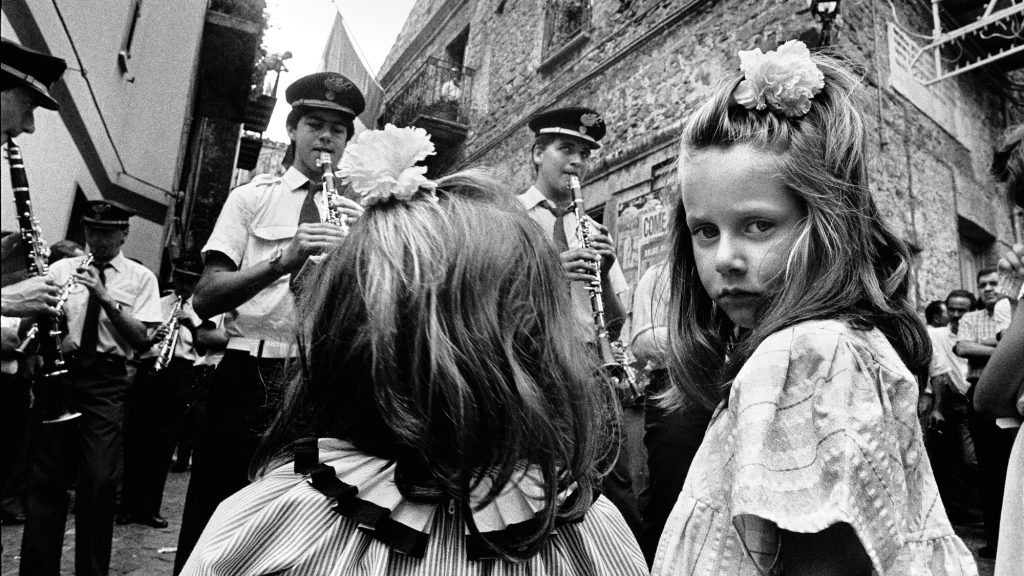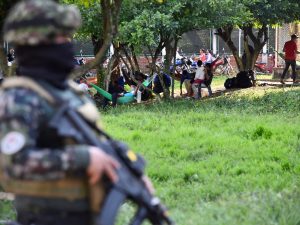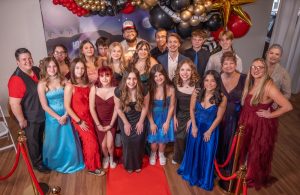
Courtesy the artist, Galerie Max Hetzler, Marian Goodman Gallery, and Galerie Jan Mot
Rineke Dijkstra — Berlin
The Dutch photographer Rineke Dijkstra is renowned for her portraits of adolescents and people in states of duress or transition—bullfighters, club kids, army recruits, new mothers. Like Diane Arbus and August Sander, Dijkstra seeks a nonjudgmental affinity with her subjects, who return her gaze with indelible precision. Her latest retrospective, presented by the Berlinische Galerie, covers more than three decades of photography and video and confirms her status as one of the greatest living portraitists. “Although my photographs are mostly portraits of individuals,” Dijkstra has said, “I like them to become more universal, like metaphors that can stand for an entire group.”
Rineke Dijkstra at Berlinische Galerie, Berlin, through February 10, 2025

© Letizia Battaglia and courtesy Archivio Letizia Battaglia
Letizia Battaglia — London
Letizia Battaglia died in the spring of 2022, in Cefalù, close to Palermo, Sicily, where she left an indelible mark as a fearless photographer who chronicled, at great personal risk, the mafia-connected violence that plagued the city. Her images feature a terrifying, bloody body count, revealing the trauma and grief organized crime unleashed on the locals. But Battaglia—who was also involved with the city council and was an impassioned activist—offered a wider view of the city’s social fabric, from receptions for nobility to the chaotic pulse of street life.
Letizia Battaglia: Life, Love and Death in Sicily at the Photographers’ Gallery, London, through February 23, 2025

Courtesy the Center for Creative Photography, University of Arizona
Louis Carlos Bernal — Tucson
Louis Carlos Bernal was born in Arizona and began his career in the 1970s, at a time when the Chicano civil rights movement energized a generation of Mexican Americans. Bernal’s revered images of homes in Tucson’s historic barrios show family pictures, television sets, movie posters, and religious shrines with an exquisite attention to detail and color. “He saw his artistic mission as a kind of moral imperative, to speak for his community and to act as a bridge, to uphold his culture to the larger world,” says Elizabeth Ferrer, curator of Bernal’s long-awaited career retrospective. Bernal’s portraits exemplify la vida cotidiana—everyday life—as a state of grace.
Louis Carlos Bernal: Retrospectiva at the Center for Creative Photography, Tucson, through March 15, 2025

Courtesy of the artist and Marian Goodman Gallery
An-My Lê — New York
“My attachment to the idea of landscape is a direct extension of a life in exile,” the photographer An-My Lê once said. In the 1990s, twenty years after her family fled Vietnam, she returned to make images of territories haunted by the specter of violence. She later photographed American military training camps and Vietnam war reenactors. Lê’s newest work, presented in darkened rooms at Marian Goodman’s expansive new flagship in downtown New York, shows the starry night skies of the Mesa Verde National Park in Colorado. The scenes are primordial and sinister, as fire lookout stations stand sentry, or an atomic-orange sunrise burns the horizon. As a meditation on what she calls the “paranoid sublime,” the exhibition provides an intriguing counterpoint to Boris Mikhailov’s Refracted Times, on view upstairs at Goodman, which considers the “changing fate” of Ukraine from the 1960s to the present.
An-My Lê: Dark Star/Grey Wolf at Marian Goodman Gallery, New York, through February 22, 2025.

Courtesy the artist
Japanese Women Photographers — Netherlands
A much-needed counterpoint to the male-dominated canon of Japanese photography, I’m So Happy You Are Here: Japanese Women Photographers from the 1950s to Now, curated by Pauline Vermare, Mariko Takeuchi, and Lesley A. Martin, presents a wide range of photographic approaches, including installation-based work, video, and the printed page. Coinciding with a book published by Aperture, I’m So Happy provides an indispensable introduction to the contributions of Japanese women to photography, showcasing intimate observations of everyday life, critical perspectives on history, and radical experiments with the medium.
I’m So Happy You Are Here: Japanese Women Photographers from the 1950s to Now at Fotomuseum Den Haag, Netherlands, January 18–May 5, 2025

Courtesy the artist
Tiny Vices — New York
In 2005, the photographer Tim Barber launched Tiny Vices, a website that featured a compelling selection of portfolios by an eclectic range of international photographers. The site quickly gained a cult following, becoming a place to explore and learn—fostering the sense of community and engagement with images that would soon be exploited by social media giants to generate dizzying wealth. In 2008, Aperture collaborated with Barber to release a series of books by photographers featured on the site. Among the roster on Tiny Vices were celebrated artists, like Ryan McGinley, older photographers who hadn’t yet had their due, and emerging voices who are now, twenty years on, regularly featured in galleries, in museums, and on the pages of magazines. “I’ve always thought of the project as a time capsule from a specific era,” Barber says. “The site itself was always shifting and hard to define. Was it a blog? A collective? A publication? An art gallery? An artwork? I was never really sure, but I always called it an archive.”
Tiny Vices Archive 20th Anniversary Exhibition at the Hole Contemporary, New York, February 8–23, 2025

© Melanie Willhide and courtesy the artist and Von Lintel Gallery, Los Angeles
Digital Witness — Los Angeles
Digital Witness: Revolutions in Design, Photography, and Film tracks the impact of Adobe Photoshop and other digital-manipulation tools on visual art from the 1970s to today. Featuring more than eighty artists, including Cory Arcangel, Petra Cortright, Loretta Lux, Thomas Ruff, and Andy Warhol, the exhibition explores how image-editing programs, by introducing new modes of layering, transparency, and scale, have altered our sense of reality. As the curators, Britt Salvesen and Staci Steinberger, note, “Software can be perceived as a neutral tool, even a creative collaborator, but ethical dilemmas—algorithmic biases, surveillance and data mining, piracy, lack of regulation, energy use—must also be confronted.”
Digital Witness: Revolutions in Design, Photography, and Film at the Los Angeles County Museum of Art, through July 13, 2025





